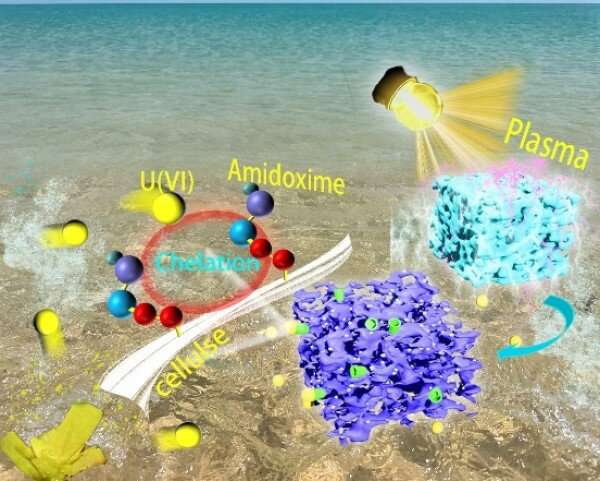This article has been reviewed according to Science X's editorial process and policies. Editors have highlighted the following attributes while ensuring the content's credibility:
fact-checked
trusted source
proofread
Researchers propose plasma-enhanced adsorbent for uranium extraction from seawater

A research team from the Hefei Institutes of Physical Science of the Chinese Academy of Sciences has developed an innovative adsorbent known as plasma light amidoxime cellulose (PLAOC) to efficiently extract uranium from seawater.
The results were published in Applied Surface Science.
Nuclear energy as a clean energy source is experiencing rapid development. The polymeric functional materials based on the modification of amidoxime groups are considered to be ideal materials for uranium extraction from seawater. However, the adsorption performance of amidoxime-based adsorbent materials is greatly affected by the environment, and the adsorption capacity measured in the laboratory is generally higher than that in real seawater.
In this study, the researchers used low-temperature plasma technology for material activation.
"Compared with conventional methods using radioactivity, we used a more sustainable and environmentally friendly approach to produce uranium-rich adsorbents," said Prof. Chen Changlun, who led the team.
The PLAOC adsorbent, created by introducing functional groups onto cellulose using plasma technology, has demonstrated exceptional uranium enrichment capabilities.
This approach focuses on surface activation while preserving the underlying structure of the material. Interestingly, the monomer to be modified does not require protection during this process.
In plasma-induced grafting technology, the energy of the active particles in the plasma can open these covalent bonds for recombination. Oxygen plasma has been used as a grafting tool to construct structures with multi-radical on the cellulose surface for subsequent grafting activation.
A crucial aspect of this groundbreaking research is that the uranium enrichment performance of PLAOC remained exceptionally high even when tested in simulated seawater. This result is significant because it demonstrates the feasibility of using plasma technology to produce uranium-rich adsorbents that can efficiently extract uranium from seawater sources.
"The results show that the plasma technology can significantly enhance the enrichment of uranyl ions at low concentrations in the preparation of amidoxime cellulose materials," said Prof. Chen.
More information: Supeng Yu et al, Preparation of cellulose@amidoxime by plasma-induced grafting technology and its potential application for uranium extraction, Applied Surface Science (2023). DOI: 10.1016/j.apsusc.2023.157883
Provided by Chinese Academy of Sciences





















